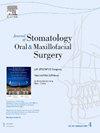颊前部缺损重建的新方法:颊黏膜瓣与颊脂肪垫串联。
IF 2
3区 医学
Q2 DENTISTRY, ORAL SURGERY & MEDICINE
Journal of Stomatology Oral and Maxillofacial Surgery
Pub Date : 2025-10-01
DOI:10.1016/j.jormas.2025.102380
引用次数: 0
摘要
背景:口腔黏膜是癌前病变的常见部位,手术切除后常留下黏膜缺损。由于颊脂肪垫固有的长度限制,其覆盖粘膜缺损的效果受到限制。如果缺损位于脸颊前部,仅依靠颊脂肪垫不足以完全覆盖患处。目前用于面颊粘膜缺损的生物膜覆盖重建入路,由于瘢痕挛缩导致严重的张嘴受限风险,对患者的生活质量产生不利影响。本研究介绍一种结合颊黏膜瓣与颊脂肪垫的新技术来治疗颊前部缺损。本研究的目的是评估颊粘膜瓣联合颊脂肪垫技术重建颊前粘膜缺损的效果。方法:对武汉大学口腔医学院口腔颌面外科收治的5例患者进行回顾性分析。该技术包括创建一个颊粘膜瓣和推进颊脂肪垫覆盖缺损。评估术后结果,包括开口和疤痕形成。结果:所有患者均获得满意的愈合,口腔开口均大于3.0 cm。无明显并发症,手术部位在3个月内完全粘膜化。结论:颊黏膜瓣联合颊脂肪垫技术是修复颊前部缺损的一种可行的方法,具有良好的功能和美观性,并发症少。这种手术方法具有相当大的实用性和广泛传播的潜力。本文章由计算机程序翻译,如有差异,请以英文原文为准。
A novel approach for reconstruction of anterior cheek defects: Series connection of cheek mucosal flap and buccal fat pad
Background
The buccal mucosa is a frequent site of precancerous lesions, and surgical excision often leaves a mucosal defect. owing to the inherent limited length of the buccal fat pad, its efficacy in covering mucosal defects is confined. In cases where the defect is anterior in the cheek, reliance solely on buccal fat pad is insufficient for complete coverage of the affected area. The currently used reconstructive approach for cheek mucosal defects, biological membrane coverage, is associated with a risk of severe mouth opening restriction due to scar contracture, adversely affecting the patient's quality of life. This study introduces a novel technique combining a cheek mucosal flap with the buccal fat pad to address anterior cheek defects. The aim of this study is to evaluate the efficacy of a combined cheek mucosal flap and buccal fat pad technique for reconstructing anterior cheek mucosal defects.
Methods
A retrospective analysis of five patients who underwent this surgical procedure at Department of Oral and Maxillofacial Surgery, School and Hospital of Stomatology, Wuhan University was conducted. The technique involved creating a cheek mucosal flap and advancing the buccal fat pad to cover the defect. Postoperative outcomes, including mouth opening and scar formation, were assessed.
Results
All patients achieved satisfactory healing with mouth openings exceeding 3.0 cm. No significant complications were observed, and the surgical sites were fully mucosalized within three months.
Conclusion
The combined cheek mucosal flap and buccal fat pad technique is a viable solution for reconstructing anterior cheek defects, offering improved functional and aesthetic outcomes with minimal complications. This surgical methodology boasts considerable practicality and potential for widespread dissemination.
求助全文
通过发布文献求助,成功后即可免费获取论文全文。
去求助
来源期刊

Journal of Stomatology Oral and Maxillofacial Surgery
Surgery, Dentistry, Oral Surgery and Medicine, Otorhinolaryngology and Facial Plastic Surgery
CiteScore
2.30
自引率
9.10%
发文量
0
审稿时长
23 days
 求助内容:
求助内容: 应助结果提醒方式:
应助结果提醒方式:


